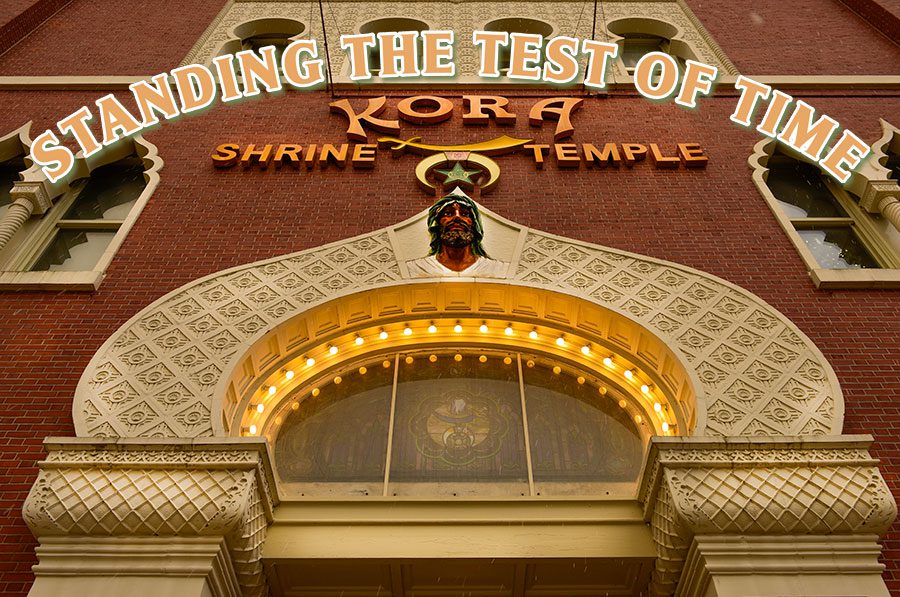Written by Jillian Netherland | Photography by Jose Leiva
Any drive through Main Street in Lewiston will take you past one of LA’s greatest not-so-hidden gems, the Kora Shrine Temple. Originally constructed in 1908, this historic building was crafted by the Ancient Arabic Order, Nobles of the Mystic Shrine, and proudly stands today at the three-way junction of Blake, Main, and Sabattus Streets, hosting events for local Shriners as well as the general public.
A century and then some
“The original Kora building was on Lisbon Street, beginning in the 1890s,” shares Barry Gates, President of the Kora Foundation and past Potentate. “Shriners International was founded in 1872 and made its way to Lewiston in 1892. Membership was growing so fast, and the building could no longer meet the demand.”
A fraternal organization associated with Freemasonry, Shriners are well-known for their charitable works. Their temples serve as a ceremonial space and clubhouse for members.
To construct a building capable of accommodating the Shriners’ growing membership that was state-of-the-art in both function and aesthetic, the early 20th century Lewiston Shriners knew there was only one person for the job: George Coombs.
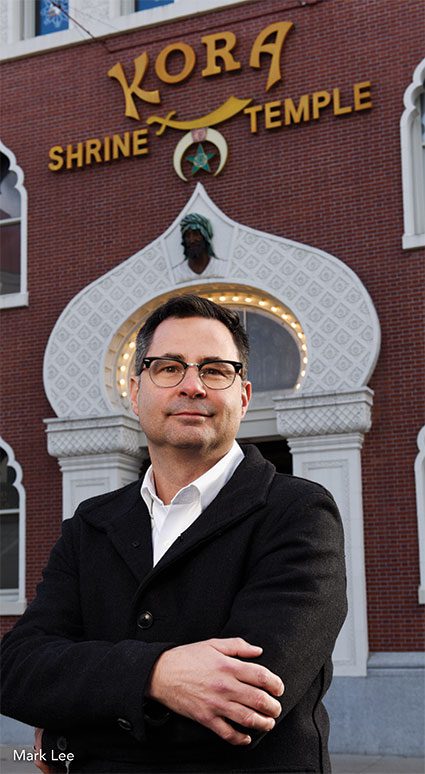 “Coombs was incredibly prolific in a lot of architecture in the Lewiston Auburn area at the time – the growing industrial center, storefronts throughout Lewiston, and even notable residential structures in the area were all designed by George Coombs,” explains Mark Lee, Principal and Chief Executive Officer of Harriman Associates, the present-day architecture firm that was once George Coombs’ company, Coombs & Gibbs. In bringing the Shriners’ vision to life, Coombs was tasked with the goal of designing a facility that was visually striking both externally and internally, that could withstand the test of time – literally.
“Coombs was incredibly prolific in a lot of architecture in the Lewiston Auburn area at the time – the growing industrial center, storefronts throughout Lewiston, and even notable residential structures in the area were all designed by George Coombs,” explains Mark Lee, Principal and Chief Executive Officer of Harriman Associates, the present-day architecture firm that was once George Coombs’ company, Coombs & Gibbs. In bringing the Shriners’ vision to life, Coombs was tasked with the goal of designing a facility that was visually striking both externally and internally, that could withstand the test of time – literally.
“All of the details of the building are beautiful and intentional, but what is truly remarkable is the integrity of the building, now 114 years old with so much of the original construction intact, something incredibly unusual for a building of that age,” says Lee. “The Temple was constructed with steel framing and masonry – brick walls, steel columns, and steel floor and roof framing. This is incredibly cutting-edge design for the era, and a true testament to the Shriners of the time who made the investment.”
In fact, Lewiston’s Kora Shrine Temple was the first building designed in the United States to incorporate both steel and wood. Standing as a three-story brick building, the Temple boasts a flat roof topped by a pair of onion domes. The main facade is ornate, with groups of pointed arch windows trimmed in terra cotta filigree predominating. At the main entrance, visitors are greeted under a rounded arch with a band of smaller, similarly arched windows on the third floor above. The building cornice consists of vaulted sections interspersed with pointed-arch niches, similar in shape to the windows. The awe-inspiring interior is ornately decorated with floor-to-ceiling murals, gold filigree and Tiffany chandeliers.
Upon completion of construction in 1909, a dedication as grand as the building itself was in order, with Shriners from all over New England traveling to Lewiston to be a part of the celebration.
“The dining hall can seat 400 people, but attendance was closer to 800, so they had to have two separate dinner seatings,” Gates shares. “Guests enjoyed a lobster dinner in the room we still use as a banquet hall today.”
Over the decades that followed, murals, details, and other ornate décor continued to be added to the Temple’s breathtaking aesthetic. In 1927, acclaimed mural decorator, Maine native, and fellow Shriner, Harry Cochrane completed decoration of the Temple, something many regarded as his most spectacular mural project, depicting scenes from Islamic and Arabic history in the Temple’s dining hall. In 1975, the building was added to the National Register of Historic Places for its distinctive Moorish-inspired architecture.
The more things change, the more they stay the same
While it may be hard to imagine parallels between life in 1909 and 2023, much of the space inside the Kora Temple has continued to be used for the same purposes over the last century. The dining hall, assembly spaces, and refreshment areas are all used for the same purposes today as they were originally built, with only the addition of smaller “support” spaces such as bathrooms, offices, and elevators, as well as safety features, including exit signs and emergency lighting.
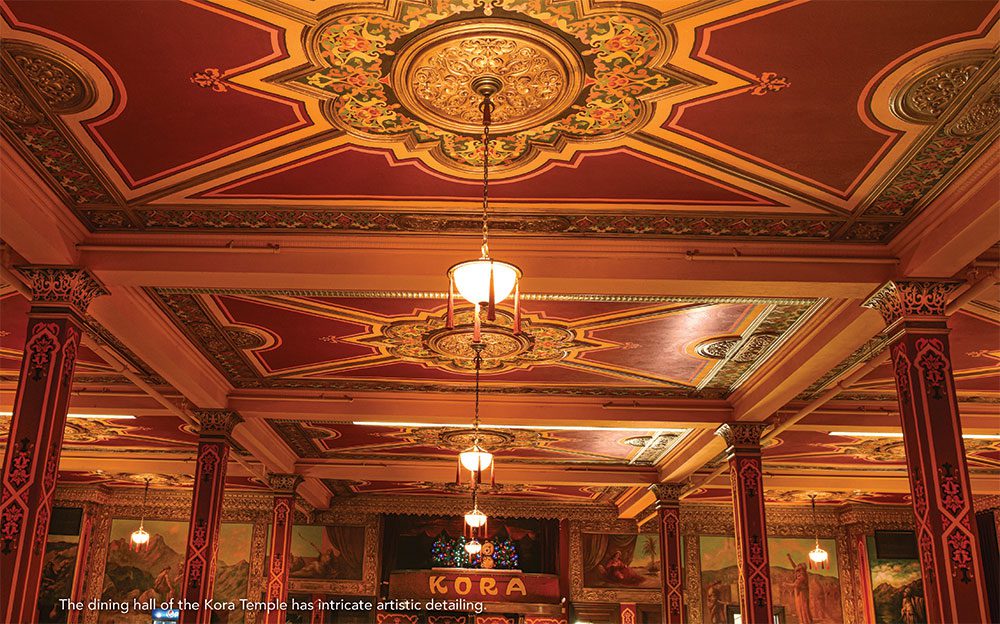
“Everyone has been incredibly careful about how they’ve supported and protected the building over time – it isn’t common to see this degree of care and conservation,” remarks Lee, adding, “part of it is it’s impossible to step foot in the building without being impressed by the level of construction and detail – I think everyone has felt a sense of pride and stewardship because of that.”
Fun, fellowship, and more
Initially built as a Shrine Temple, the building is now more commonly known as the Shrine Center, but don’t let the name change confuse you – just as the internal space of the building has remained consistent through the years, so has the intent of those who utilize it.
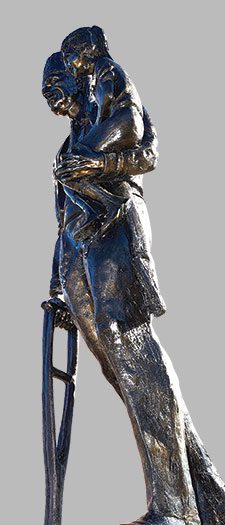 “Shriners International was founded to have fun and fellowship in a public way, and that is still what we’re all about,” explains Gates. “The organization has always been about raising money, specifically for children’s hospitals, with a common meeting place for business and fun, such as dances, plays, and other productions.
“Shriners International was founded to have fun and fellowship in a public way, and that is still what we’re all about,” explains Gates. “The organization has always been about raising money, specifically for children’s hospitals, with a common meeting place for business and fun, such as dances, plays, and other productions.
For LA residents, the most well-known public production at the Kora Temple is the Feztival of Trees, held annually during the week of Thanskgiving. Trees are sponsored, decorated, and put on display by local businesses and nonprofit organizations to raise money for the Shriners. Attendees purchase tickets to attend the event and enter raffles to win items on and beneath the trees.
“The Feztival is our biggest fundraiser, for sure,” says Rob McKinley, 2022 Potentate. “2022 was our 17th year hosting the event, and we have never reused a theme to ensure it’s something enjoyable that people will want to keep coming back to each year.”
While the Feztival of Trees may be the Shriners’ largest fundraiser, it isn’t the only one. Heading into its third year in April 2023 is the Annual Kora Shriners Sportsmen Expo. Aiming to share the love of the outdoors while providing opportunities for education and exposure to the Shrine, the expo features vendors promoting outdoor activities for the entire family, including skiing, fishing, hunting, and camping, as well as ATV riding, kayaking, and backyard game enjoyment.
“We also hold team meetings at the Temple for each year’s Maine Shrine Lobster Bowl Classic,” shares Gates. Keeping true to the Shriners’ historic support of children’s hospitals, funds raised through the Lobster Bowl Classic benefit Shriners Hospitals for Children pediatric healthcare system, which provides free medical care to children. These funds are raised by local football players and cheerleaders who have been nominated by their coaches and agree to raising a certain amount of money to participate.
“Each year, a child patient will speak with the football teams and cheerleading squads so they can learn where the money is going and why raising it is so important,” says Gates. Known as the premiere sporting event in Maine, Lewiston High School’s football field has served as the Lobster Bowl Classic’s venue for the past two years, with Thornton Academy and Biddeford High School hosting in years past.
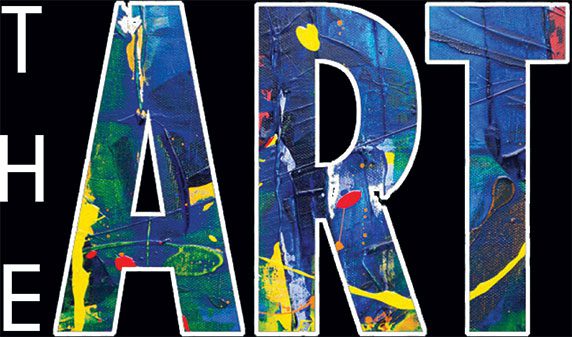
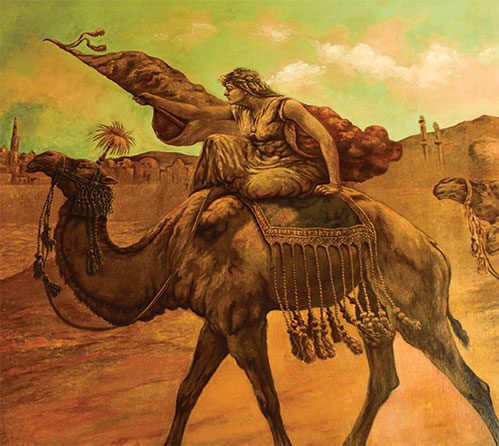
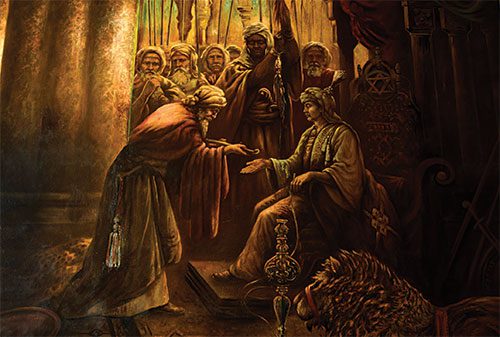
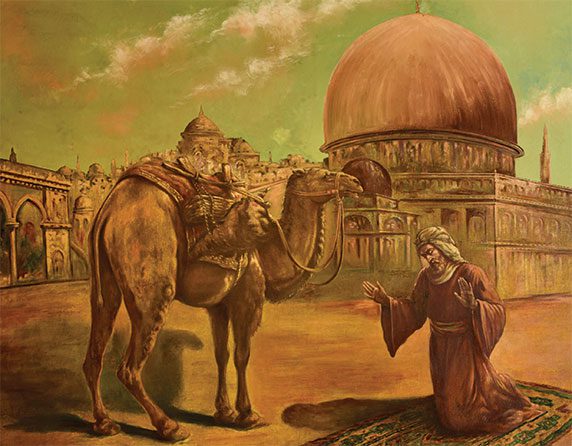
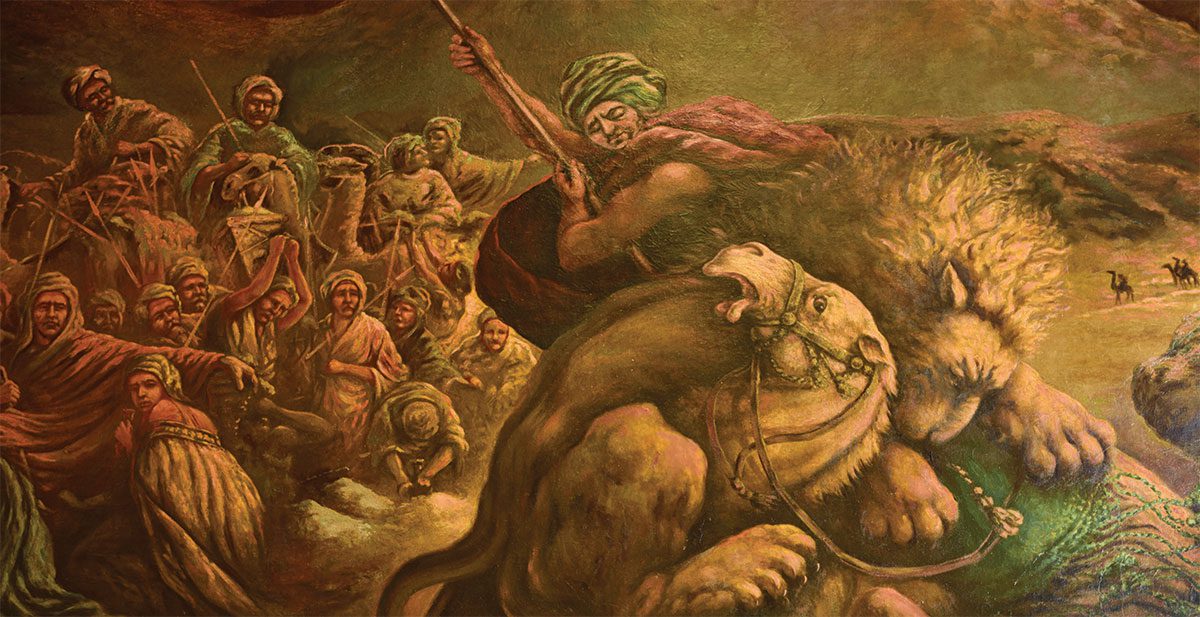
Beautiful paintings adorn the walls of the Kora Temple.
It takes a village
Each year’s Potentate project is outside the realm of typical fundraising events. With terms lasting for one calendar year, each Potentate, similar to a club President, has the honor of selecting a fundraising project to spearhead and bring to fruition.
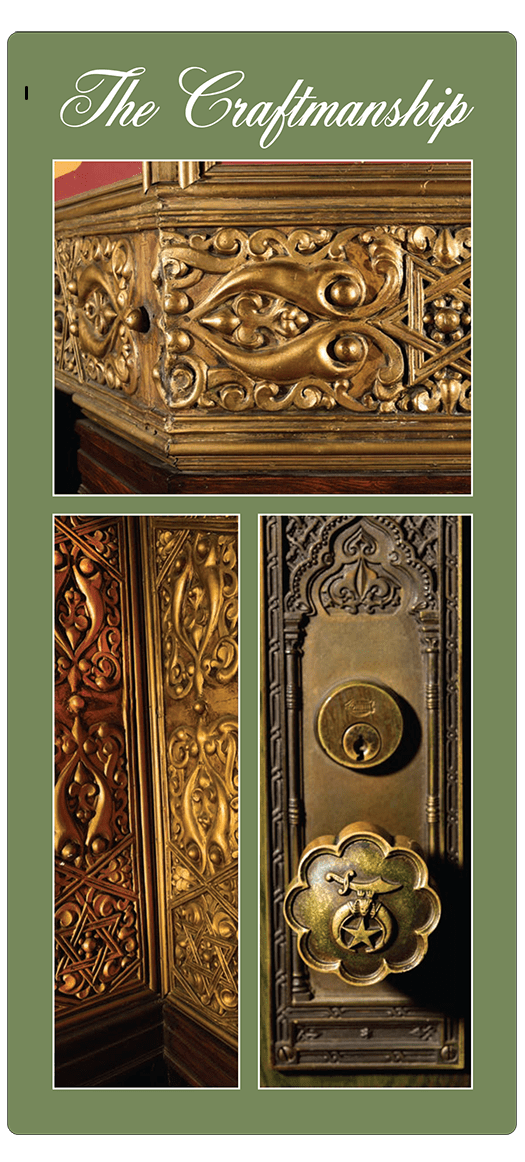 “In 1970, at a fair in Indiana, a Shriner was carrying a disabled child from spot to spot, ensuring she got to enjoy the fair as much as anyone else. Someone snapped a photo which has since become a statue at Shriner temples across the country called the ‘Silent Messenger.’”
“In 1970, at a fair in Indiana, a Shriner was carrying a disabled child from spot to spot, ensuring she got to enjoy the fair as much as anyone else. Someone snapped a photo which has since become a statue at Shriner temples across the country called the ‘Silent Messenger.’”
For McKinley’s Potentate project, he chose to have a statue of the Silent Messenger installed at the Kora Temple, but he took his fundraising aspirations one step farther than the statue installation: enough funds were raised to have the little girl depicted in the statue, Bobbi Jo Wright of Evansville, Indiana, now 58 years old, flown to Maine to be a part of the statue’s unveiling on December 3, 2022.
It takes a village to keep a historic building – and the organization that calls it home – in optimal working order for more than a century. The secret to success for the Kora Shriners is a combination of diversification in unity through three distinct corporations under one overarching umbrella: the Kora Association, the Kora Foundation, and the Kora Fraternity, each with their specific role in support of the organization.
“Our primary responsibility is to own and manage the building,” states Dan Labrie, President of the Kora Association. “We have a board of trustees elected for membership who vote on where to spend money in the best interest of the building.”
One of the first things the board did was request an evaluation of the condition of the building and prioritized investments to protect the building, starting in 2016. Funds for these investments come from none other than the Kora Foundation.
“The Foundation is a 501c3 nonprofit that began in 2012 with the sole purpose of raising money for the Kora building,” explains Gates. In addition to community events, like the Feztival of Trees and Sportsmen Expo, the Kora Foundation raises funds through annual mailings and planned giving through wills and bequests. Its next major fundraising campaign will be geared towards replacing the Temple’s HVAC system.
“The Foundation was started in the spirit of preserving the building,” shares Lee, who is not a Shriner himself, but is a part of the Foundation. “The building itself is a beautiful landmark in our community, and I have a great interest in being a part of its preservation.”
If the Foundation and Association support the pursuit of fun and fellowship, the Kora Fraternity is the fun and fellowship brought to life. Comprised of 22 units, six clubs, and special interest groups such as a brewers’ club, Kora Klown unit, a band, and different parade units, the Fraternity oversees the many subgroups of Kora, led by the year’s Potentate.
The next 100 years and beyond
In looking to the future, a collective goal in preserving the Temple for another century and beyond is sharing it more with the public – including its history.
“A lot of people walk past and have no idea what the building is, making it something of a mystery at first glance,” tells Lee. “Through changing and adding more function to the building itself, we hope the community can enjoy how precious and wonderful the building is – it’s great to see it being shared more and we encourage everyone to enjoy the fact that this is such a special building in our community.”
Kora Temple Shrine
11 Sabattus Street, Lewiston • korashriners.org

